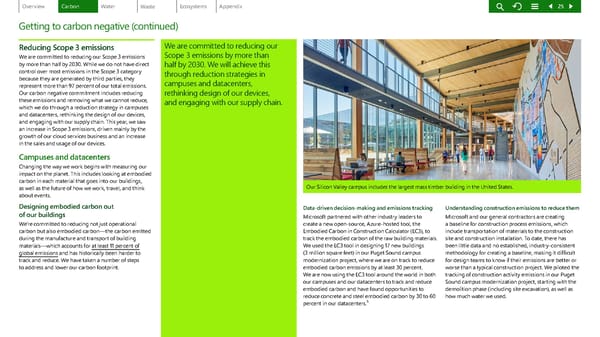25 Getting to carbon negative (continued) Reducing Scope 3 emissions We are committed to reducing our Scope 3 emissions by more than half by 2030. While we do not have direct control over most emissions in the Scope 3 category because they are generated by third parties, they represent more than 97 percent of our total emissions. Our carbon negative commitment includes reducing these emissions and removing what we cannot reduce, which we do through a reduction strategy in campuses and datacenters, rethinking the design of our devices, and engaging with our supply chain. This year, we saw an increase in Scope 3 emissions, driven mainly by the growth of our cloud services business and an increase in the sales and usage of our devices. Campuses and datacenters Changing the way we work begins with measuring our impact on the planet. This includes looking at embodied carbon in each material that goes into our buildings, as well as the future of how we work, travel, and think about events. Designing embodied carbon out of our buildings We’re committed to reducing not just operational carbon but also embodied carbon—the carbon emitted during the manufacture and transport of building materials—which accounts for at least 11 percent of global emissions and has historically been harder to track and reduce. We have taken a number of steps to address and lower our carbon footprint. We are committed to reducing our Scope 3 emissions by more than half by 2030. We will achieve this through reduction strategies in campuses and datacenters, rethinking design of our devices, and engaging with our supply chain. Our Silicon Valley campus includes the largest mass timber building in the United States. Data-driv e n decision-making and emissions tracking Microsoft partnered with other industry leaders to create a new open-source, Azure-hosted tool, the Embodied Carbon in Construction Calculator (EC3), to track the embodied carbon of the raw building materials. We used the EC3 tool in designing 17 new buildings (3 million square feet) in our Puget Sound campus modernization project, where we are on track to reduce embodied carbon emissions by at least 30 percent. We are now using the EC3 tool around the world in both our campuses and our datacenters to track and reduce embodied carbon and have found opportunities to reduce concrete and steel embodied carbon by 30 to 60 percent in our datacenters. 5 Understa nding construction emissions to reduce them Microsoft an d our general contractors are creating a baseline for construction process emissions, which include transportation of materials to the construction site and construction installation. To date, there has been little data and no established, industry-consistent methodology for creating a baseline, making it difficult for design teams to know if their emissions are better or worse than a typical construction project. We piloted the tracking of construction activity emissions in our Puget Sound campus modernization project, starting with the demolition phase (including site excavation), as well as how much water we used.
 Environmental Sustainability Report | Microsoft Page 24 Page 26
Environmental Sustainability Report | Microsoft Page 24 Page 26